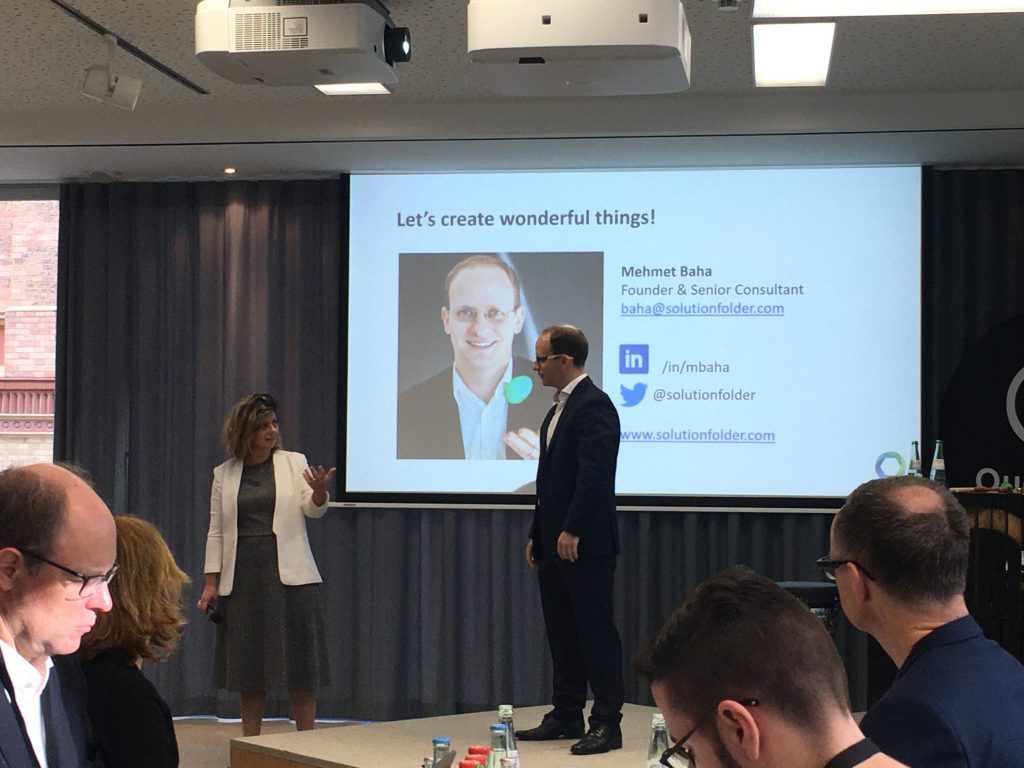
24-25th October saw the good folks from Quadriga hold their Internal Communications Conference in Berlin. This event is run by a fine chap called Santiago and has been running for several years. It’s a very well respected marketing event for senior management and above with an interest or involvement in internal communications.
As a first-time participant and speaker I wanted to share some thoughts and reflections after attending the event. It’s my first time at an internal communications conference. Here are the six points that registered with me.
-
It’s good to get out
It was a pleasure to meet lots of fantastic people. The whole vibe of the event was great. Very accessible, down-to-earth and focused on collaborative learning. No egos in sight. Amen to that. I even met some people who I’ve known for years but have never met in person – Martina Olbertova comes to mind. It’s easy to get caught up in the day-to-day of delivering projects and meeting deadlines but attending conferences always reminds me that it’s good to get out. This internal communications conference reinforced this perspective for me.
-
Fresh perspectives
Stepping outside my usual world of “Brand Land” was a real positive. Very refreshing. For most client engagements I need to look at challenges through a pretty wide strategic lens. This event made me realise I need to go to Specsavers if I want to be better at my job.
-
The need for holistic thinking
It was surprising to see how focused on internal communications most participants were. This may sound like a painfully obvious statement as it’s their job! However, for internal communications to deliver real value it needs to dovetail with broader external communications. It also needs to support marketing and corporate objectives. Being able to ladder up this logic so that internal communications aligns with corporate objectives was something I didn’t get a sense for during the conference. On more than one occasion marketing and communications objectives were seen as synonymous. This leads me to believe there’s work to be done.
-
Frustration with a lack of clout
A perceived lack of organisational influence seemed to plague a number of participants that festered in frustration. In many respects this felt like a blast from the past when branding folk experienced similar discontent. Frustrating and disheartening in equal measure. This brings me to my next point….
-
The need to embrace a data-driven approach
Internal communications folks need to embrace a more data-driven approach when it comes to plying their trade. Not once did anyone mention how the decisions they take or communications they create are driven by data.
- Why not use methods like regression to identify which parts of the message generate a strong (negative or positive) emotional response from employees?
- How about using structural equation modelling to identify what feelings influence which thoughts and ultimately employee behaviour?
Such insights could then help fine-tune and so sharpen subsequent communications. Using data in these ways is increasingly the brand marketing norm. But I didn’t sense that was the case with internal communications – unless I missed a trick.
-
Perceptions of senior management
The overwhelmingly negative perception of executive management took me by surprise.
Executive management were regarded as aloof and disconnected from the workforce. There was a view that the c-suite considered internal communications passively at best – or as delivering no value at worst.
Based on my dealings with the c-suite this surprised me. Most, if not all, senior executives understand the need to inform and engage with their organisation – especially those who work at services brands. Internal communications plays a key role in doing this. I’m not sure why this disconnect exists but it’s something CMOs need to keep an eye on. If not, alienation within the realms of internal communications will follow.
Summing up
The different perspectives I encountered during this internal communications conference gave me a welcome jolt. The point isn’t whether I agree with them or not. It’s more the case that it was a timely cue for greater self-reflection in the context of the Brand Laa Laa land that I may be guilty of living in from time to time.
The frustrations around a lack of organisational clout internal communications folks felt can be empathised with. I think most marketers, of whatever guise, have experienced that. Adopting a more holistic, scientific and data-driven approach to internal communications will help get the ear of those in the c-suite. I’ve seen that work first hand with brand so would encourage communications folks to give it a go.
Here are some of my key takes from the sessions.
Be part of the picture: Engaging engagement by Jane Cordelia O’Farrell (FAO)
An absolute internal communications masterclass from Jane Cordelia O’Farrell. Jane’s internal campaign engaged and galvanised the Food and Agriculture Organization behind a core goal of eradicating world hunger. Inspiring and meaningful in equal measure. There was also a nice blend of old school, e.g. corridor canvassing, and newer approaches, e.g. influencers.
Key bits of advice:
1) Keep it simple
2) Does it resonate?
3) Add a feel-good factor


Achieving Change by Steffen Henke (Vodafone)
Steffen Henke from Vodafone delivered a very detailed and open account of how tech can be used to facilitate internal communications and engagement.
Key takes for me?
- To make internal communications more engaging Vodafone Germany dropped the standard Intranet approach and fed content through an app. This was seen as a way to compete with other apps such as Instagram etc. when an employee was on their way home, etc.
- Vodafone has developed a podcast – which has proven popular
- Gamification was used as an internal engagement and education tool. For instance, employees received credits for reading articles, commenting on an article, etc. This translated into gifts, e.g. a Ferrari (only joking), free coffee and enhanced digital ranking in the business.
The Value and Power of Inclusive Communication by Sarah Cordivano (Sr. Diversity & Inclusion Officer, Zalando)
Sarah Cordivano from Zalando SE delivered a super interesting talk on diversity and inclusion. This really opened my eyes to what diversity and inclusion really mean and the work that needs to be done.
Key takes from Sarah’s talk? Empathy, culture and inclusion are the key to inclusive communications
Collaborative Leadership by Mehmet Baha (Solution Folder)
Mehmet Baha delivered a great talk on collaborative leadership. It was the closest I’ve come to dancing at a conference. He put some beats in my bones!
Key takes for me on the characteristics of effective leadership:
- Active listening. Focus on listening vs. thinking about what you’d like to say. This means you give people your full attention.
- Create synergy between teams and within teams, e.g. the composition of team members.
- Work together in a coordinated way. “Multiplex ties” and “structural holes” facilitate synchrony.
Making your Employees True Brand Ambassadors by Hendrik de Wit (Intertrust Group)
Hendrik de Wit from Intertrust Group shared a super interesting employee engagement/employer branding case study. Many stages looked quite familiar to previous projects (which was reassuring).
Some key points for me.
>Employee journey drives business performance. (This was music to my ears but I’d also add this relationship is mediated via brand.)
>Parallels and common principles exist between customer and employee experiences in terms of stages and process. This brings us into the realms of utilising customer journey maps as a tool for enhancing the employee experience.
Internal Communications at Maersk Line by Mette Refshauge (Maersk Line)
Mette Refshauge outlined how she goes about internal communications at Maersk Line, Limited
Key takes for me?
- “We work hard to create a core narrative that can work across channels.”
- “The best investment is to create a core narrative.”
- “There’s a need for internal communications teams to have strategic and tactical skills. The latter is important so employees can work with change, uncertainty etc., so they can deliver/implement.”
- “We need a new type of agency that can implement internal communications as we can’t do everything ourselves.”
- “Universities should stop teaching communications strategy but focus on helping students to interpret and communicate the business strategy.”
You can learn more about next years internal communications conference here.
A short note of thanks should also go to Helge Schlüter who introduced me to Santiago and so creating this speaking opportunity. Dankeschön (courtesy of Google Translate!)
*****************************************************
>Why not download the first chapter of Building Brand Experiences for FREE here?
>Learn more about our forthcoming Advanced Brand Experience Bootcamps here.












Hi, great synopsis! Just a comment, the reference to the World Health Organization should be to the Food and Agriculture Organization instead 😉
Ahh. I see. Apologies for that. The change has just been made. Glad you enjoyed the post 💫